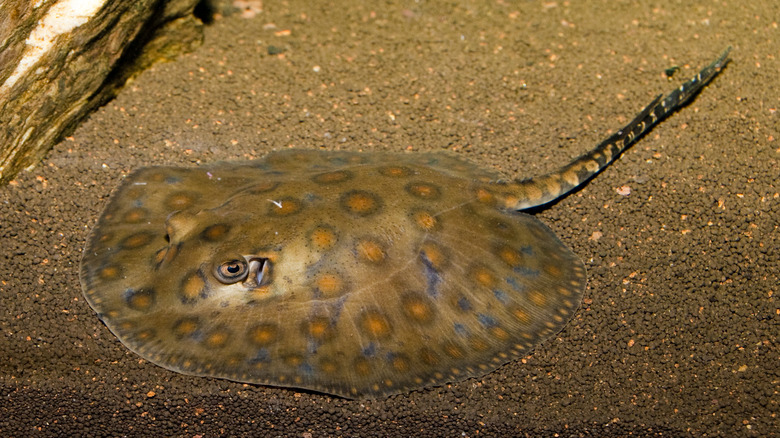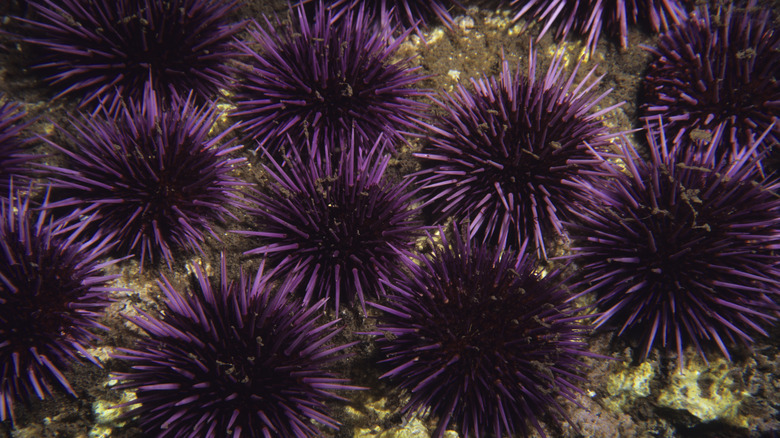5 Creatures To Beware Of When Swimming In California's Oceans
The nearshore waters of the Pacific Ocean off the coast of California are teeming with a myriad of oceanic creatures. These same waters also draw millions of people to the coastline each year, many of whom are hoping to get an up-close look at the fish and animals that live there. While this marine life can be stunning and awe-inspiring to gaze upon, running into them while swimming can also be dangerous — and even downright deadly. As a result, not every encounter with these animals ends well. Every year, thousands of people are injured in these waters from bites, stings, or stabs by water-dwelling creatures. An untold number of more minor incidents and injuries go unreported.
This is not to say it is unsafe to get in the water. By all means, it is entirely possible — and quite common — to have a fun-filled, incident-free day at the beach! However, here are five creatures you need to beware of when swimming in California's ocean waters.
Seals and sea lions can become aggressive in certain situations
Yes, these are two separate species. They are grouped together here because they usually inhabit similar areas and are both typically docile and harmless. However, they can each become aggressive and inflict serious wounds on humans in certain situations.
These ocean mammals spend a portion of each day on land, so they are likely to be encountered in a variety of scenarios — on dry land sunning or resting, in shallow waters as they move on or off the land, or in slightly deeper waters as they are foraging for food. Whether onshore or in the water, so long as they keep their distance when observing seals and sea lions, swimmers typically have nothing to fear. Issues typically only arise if these animals feel threatened or that their pups are in danger. Then, they can become aggressive and use their hefty bodies and sharp teeth and tusks to inflict damage. This typically happens when someone encroaches on their space or gets between them and their pups.
Stingrays can attack, but only when provoked
Most people associate sting rays with warm tropical and semi-tropical waters. While many species of rays do prefer more temperate climes, some, most notably the California round stingray, are right at home in these waters. In fact, southern California, in particular, has a high population and growing numbers of rays. Round stingray numbers in the region have risen so dramatically since the 1970s that Southern California has been dubbed the "Stingray Capital of the World" by the ABC News affiliate in Los Angeles.
The good news for beachgoers is rays only attack as a defensive reaction. The bad news — swimmers and beachgoers can accidentally step or land on unseen rays buried beneath the sand in shallow water, inadvertently causing this defensive reaction. When this happens, the ray is capable of inflicting serious damage with the sharp, spiked barb located at the base of their tail. The best way to avoid such an unfortunate encounter is to shuffle your feet on the ocean floor as you move so as to warn the ray of your approach and to ensure you do not step directly on top of it.
Given the frequency of incidents, it is also imperative swimmers and beachgoers know what to do if they are stung by a stingray before heading to the shore.
Shark-related incidents have been on the rise in California
Of course, the creature found off the California coast that is almost universally viewed as one to beware of is the shark. While several species of shark are found in these waters, including bull, dusky, leopard, blue, thresher, mako, and tiger, among others, it is the Great White that commands the most attention.
Although several of these species swimming in coastal California waters are considered dangerous sharks, encounters with these animals, even white sharks, are relatively rare. However, the number of shark-related incidents has been rising, according to the California Shark Incident Statistics maintained by the California Department of Fish and Wildlife. It hasn't been definitively determined if the rise in incidents over the past few decades is due simply to an increased number of humans in the water, a change in shark behavior, or some combination of those factors.
In any event, the best ways to avoid an unwanted shark encounter are to follow what most consider universal precautions when swimming in waters that are home to sharks: don't swim during lowlight hours, don't swim alone, avoid swimming near schools of fish, don't wear flashy jewelry or bright-colored clothing, and don't go in the water when sharks are known to be around.
Jellyfish can be avoided with a sharp eye
Mesmerizing to look at it, jellyfish can equally be painful if they come in contact with human skin. The part of the anatomy that makes jellyfish dangerous is the trailing tentacles that are full of venom-tipped barbs. These are designed to capture and paralyze small fish for the jelly to ingest. However, they can cause quite an unpleasant sensation in humans if touched. In general, jellyfish stings cause more pain and discomfort than serious injury, and knowing what to do if stung by a jellyfish can help mitigate any lingering effects.
Swimmers can typically avoid incidents by keeping a sharp eye out to spot jellies, then avoiding the back end (do keep in mind, some tentacles can trail for several feet behind the jellyfish). As is the case in most salt waters bordering the U.S., jellyfish are more common along the California coast in the warmer months. During times of high concentrations, when multiple jellyfish are easily spotted with a quick glance from shore, it is best just not to get in the water as contact is almost unavoidable. If jellyfish are found in abundance and staying on dry land is not an option, the best bet is to wear a protective layer such as a wetsuit.
Simply look at the ocean floor to stay away from sea urchins
Swimmers along the California coast are frequently injured by spiny spikes of sea urchins. This is somewhat surprising considering that while urchins are dangerous, they are easy to avoid since they are stationary. But, if contact is made with the sharp, venomous spines of a sea urchin, the pain almost immediately ensues. While very sharp, these spines are also very brittle and often break off in tissue, which can lead to a serious infection.
Most often, these injuries occur when swimmers are getting in or out of the water along rocky shorelines or while swimming/snorkeling near rocky outcrops. So, awareness is definitely the key to avoiding an unlucky encounter with a sea urchin. Swimmers should be sure to have an entry and exit point clear of sea urchins. If snorkeling or diving is on the agenda — an activity when it may be necessary at times to grab rocks for stability — wear thick dive gloves to prevent the spikes from penetrating the skin.





